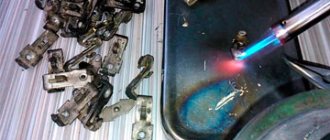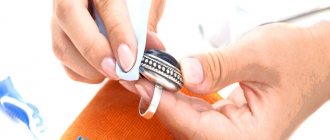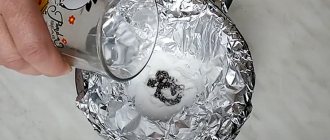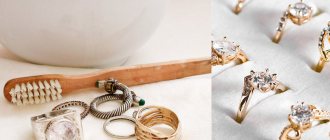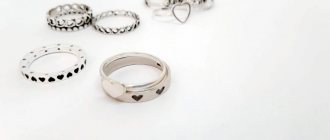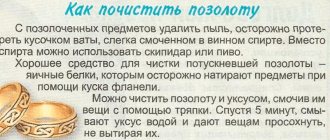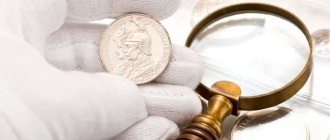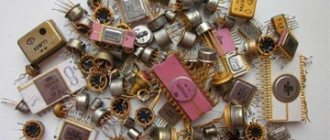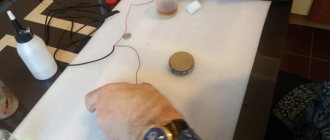December 14, 2019
To process scrap radio components with the subsequent release of silver, a physical and chemical process is used, which is called refining. It is a set of physical influences and chemical reactions that ultimately lead to the release of a precious metal of high purity. The method is quite time-consuming, since the speed of the chemical reaction is influenced by many factors, the main one being the degree of contamination of silver with various impurities.
The way in which the refining is carried out also contributes - do not forget that all operations will require chemical reagents, minimal skills in working with laboratory equipment and a safe environment for carrying out operations. Let's talk in more detail about the execution of the silver refining process using various techniques.
How do acids interact with silver?
Silver is chemically inactive, so it belongs to the family of noble metals. In the air, silver (as a chemical substance) practically does not oxidize, does not interact with water, and is an inert metal. Under normal conditions, silver reacts weakly with various acids. This is explained by the fact that in the electrochemical series it comes after hydrogen. Silver does not react chemically with hydrochloric and dilute sulfuric acid.
Silver is oxidized by reaction with hot concentrated sulfuric acid and hydrochloric acid in the presence of free oxygen. Silver can react chemically with acids that exhibit oxidizing properties, that is, contain oxygen.
The properties of silver, weak interaction with acids, are actively used in production:
- silver dishes,
- silver spoons and forks,
- silver jewelry,
- silver coins, awards and badges.
Silver is resistant to many cold and hot acids, alkalis and salt solutions, as well as a number of organic compounds. Cold hydrochloric acid acts slowly on silver by forming an insoluble film of silver chloride.
In this article we will look at the following chemical reactions:
- reaction of silver and hydrochloric acid;
- reaction of silver and sulfuric acid;
- reaction of silver and nitric acid.
Process description
Before you start refining silver at home, you need to study in detail all the intricacies of the process and carry out various preparatory activities. This will help simplify the procedure for cleaning precious metal and complete it in a minimum amount of time.
To refine precious metal, you can use various objects that contain this material.
Among them, the most commonly used are:
- technical silver contained in transistors, relays and other radio components;
- old jewelry that is unsuitable for wearing;
- sludge from electrical cleaning of silver;
- silver foam, which is a waste product generated during the refining of lead.
The refining process is quite expensive, so its implementation should be approached with all responsibility. The first step is to decide on a method for purifying silver from impurities. This choice is made based on the following factors:
- amount of material available for cleaning;
- condition of the metal being processed;
- the need to ensure process continuity.
How to get pure metal?
The third stage of electrolysis requires:
- the bottom of a plastic bottle (two-liter);
- power supply;
- coffee filter;
- stainless fork;
- brass stick;
- electrical tape;
- insulation tubes.
Pure silver is welded to a fork, but so that the edge of the ingot remains hanging. Using electrical tape and pliers, an imitation cathode is made from a fork. An anode stick is passed through the filter, and distilled water is added to the silver solution so that the total volume of the solution is two liters.
The resulting solution is poured into the cut-off part of a plastic bottle, a stick with a tea filter is suspended and a fork is immersed in the container. After all this, turn on the power supply, while monitoring the current (it should not exceed 5 amperes) and voltage (permissible fluctuation from 4 to 8 volts). The reaction will cause the bar to dissolve and crystals to separate. The crystals are washed and then fused by casting into water. All these techniques allow you to obtain silver of a maximum 999 standard.
When working with metal and reagents, you should follow safety rules - protect your hands with gloves, avoid contact of chemicals with mucous membranes, and also work in a well-ventilated area.
Final Filtration
When refining silver by electrolysis at home or by any other method, you must follow basic rules and take into account the recommendations of professionals.
It is also important to remember about such a stage as filtration. To separate the metal from the solution, use a funnel and filter paper . A solution with cement is placed in the prepared reservoir, and copper salts flow down through a layer of parchment. As a result, the silver remains on the surface. To complete the procedure, you need to rinse the filtrate another 5 times with purified water.
The remaining composition will contain a small amount of silver, which can be obtained by adding table salt. The cement is then thoroughly dried and placed in a crucible. The sample must be heated evenly to prevent the possible release of silver or oxidized dust. Also, baking soda and borax should be applied to the surface of the alloy, which are mixed in equal proportions. In this case, the composition will create a glassy film over the metal, preventing possible losses.
The final product cannot boast of a high purity, so for deeper cleaning you will have to use the electrolysis method.
Mistakes when refining silver
- Excessive amounts of nitric acid will lead to a bad reaction, the release of nitric oxide (“red tail”) in particular.
- The vertical arrangement of the electrodes one above the other when refining silver by electrolysis significantly weakens the effect of the electrolyte, and the silver is separated very slowly.
- During electrolysis, excess current can produce silver oxide, causing the precious metal to turn black.
- A fatal mistake is failure to follow safety rules when refining silver by any method. Inhalation of toxic chemical fumes, burns, etc. will not please the silver miner.
Chemical properties of technical silver
The very concept of “technical silver” is used for secondary precious metal obtained by processing equipment, and for material used in technology.
The properties of lunar metal that have contributed to its widespread use are plasticity, high reflectivity, and increased chemical resistance. The metal does not react with oxygen, hydrogen, nitrogen, carbon, or silicon.
Technical silver melts at temperatures from 780 to 962 °C, boils at 2210 °C.
The essence of the procedure
In order to obtain purified silver from technical silver, techniques are used to rid it of various impurities. The combination of all methods is called refining. At its core, this procedure is an industrial process, but all the necessary manipulations can be performed at home.
For cleansing, you can use items such as:
- any silver jewelry;
- sludge obtained during electrical processing of argentum;
- technical scrap containing impurities;
- lead industry waste.
Pure argentum can be obtained from radio components, silver-plated parts and silver contacts, as well as fragments of ores obtained during mining.
Home methods of silver refining include the following techniques:
- chemical chlorination;
- cupellation;
- electrolysis.
The final choice of refining option depends on factors such as:
- amount of metal processed;
- the ability to ensure continuity of the technological process;
- the initial state of the alloy being processed.
Rules of care
You need to keep an eye on the silver contacts. Care involves periodically checking their condition. If they are dirty, you should clean them with a suede or cloth cloth . It will need to be moistened a little in gasoline. Can be cleaned with a stiff hair brush.
Sales of production
Do not forget that activities for processing scrap and waste of precious metals are subject to licensing in accordance with the legislation of the Russian Federation.
Individual entrepreneurs and legal entities have the right to buy and process the remains of precious metals if they have a certificate from the Assay Office.
If you try to sell metal that you yourself obtained from radio components to buyers, you should find out about criminal liability for illegal mining and sales.
Violations are regulated by Article 15.44 of the Code of Administrative Offenses, which states: the amount of the fine will be one or one and a half times the cost of the materials that are the subject of the offense.
Cost of various samples
The cost of any sample depends on the price of pure precious metal established by the Central Bank of the Russian Federation. To determine the current cost of the sample, you need to multiply the current price of the highest alloy by the required coefficient.
Current sample prices for 2021:
| Try | Cost per gram, rub. |
| 999 | 37 |
| 960 | 35,5 |
| 925 | 34 |
| 875 | 32 |
| 830 | 30 |
Silver from radio components usually has 999, 960, 875 standards.
Sales points
Buyers should be looked for on thematic forums and websites, among private advertisements. Pawn shops and purchases accept such metal several times cheaper than its real value.
If there is no license permitting the extraction of precious metal from recycled materials, you can try to make simple jewelry yourself from the resulting silver.
Recommendations
Since work is carried out with aggressive chemicals, it is necessary to strictly follow the safety rules:
- be sure to ensure good ventilation of the room (it is better to work outdoors);
- use skin and mucous membrane protection: gloves, goggles, masks or gauze bandages;
- add only acid to water, never the other way around.
- check for the presence of a chemical reagent by dropping the shavings using tweezers. If it does not dissolve, add HCl to remove zinc from the deposited metal.
You can make good money by purifying silver and refining it. The profit in this business will be many times greater than the costs.
Available tools and materials
To refining silver at home and obtain metal without impurities, you need a little knowledge of chemistry (at the high school level), as well as the following materials:
- nitric acid 68.8%;
- deionized water;
- glass container;
- scales;
- quartz and brass sticks;
- titanium crucible (container for fusion);
- copper tubes or any other copper products;
- coffee filters;
- any power supply;
- plastic lemonade bottle;
- stainless steel fork and electrical tape;
- tea filter;
- insulation tube.
Safety regulations
As for safety rules, they must include complete ventilation of the room in which the procedure is carried out. For personal protection, you need to use gloves, a gown and special glasses, and to avoid splashing the acid into the water, you need to add the concentrate itself.
If we talk about the safest ways to obtain silver, the exchange reaction takes the leading place. In this case, ammonium nitrate must be mixed with the electrolyte, after first making sure that the chemical container is reliable and resistant to temperature influences. Sometimes the heat of the process reaches 100 degrees. To prevent acid splashing, the solution should be poured into 1/3 of the vessel.
In fact, silver refining is a completely feasible process that can be done at home. It is enough to show a little diligence and follow the instructions exactly , paying attention to the advice of professionals. If you follow basic safety rules, the process will be successful even in a home garage.
To ensure that the final metal has a high purity, it is recommended to give preference to the refining method by electrolysis. It reduces the likelihood of impurities entering the composition, since it involves the use of electric current.
Source
List of silver-containing components in electronics
The main sources of silver recyclables for refining are radio and electrical devices. In addition to lunar metal, devices can contain gold, palladium, tantalum, and platinum.
Soviet microcircuits
The largest amount of silver plating is found on microcircuits manufactured before 1990.
If we compare these Soviet parts with others, they are quite promising for refining. The most lunar metal per 1000 units of microcircuits contains:
- 1200ЦЛ2 - about 120 grams;
- 1200TSL1 - about 114 grams;
- 1200M1 - about 90 grams;
- K57ZRF41/42 - about 70 grams;
Technical silver
Electronic machine capacitors
Capacitors can be found inside computing devices, tube televisions, tape recorders, and telephone exchanges.
A significant amount of precious metal per 1000 units of parts contain:
- ETO-4 600*10 - 14163.6999 grams;
- ETO-4 - 8345.16 grams;
- ETO-3 400*2 - 2450 grams;
- ETO-3 - 1655.07 grams;
The cost of one capacitor varies from 50 to 5000 rubles.
Radio resistors
The most valued are variable resistors whose copper terminals are treated with high-grade silver.
The prevailing amount of precious metal per 1000 units contains:
- UN-100 – 207 grams;
- UNU50 – 132 grams;
- UN 25 – 67 grams;
Resistors are among the most widely used elements in electronics.
Domestic and imported connectors
Connecting elements are used to temporarily connect electrical conductors using mechanical contact.
Imported connectors are less preferable for refining, since they are three times inferior in precious metal content to Soviet ones.
A lot of lunar metal can be obtained from connectors: RG1N-2–31 RG90–5 (socket) RMG-39B45Sh2A1 RG1N-2–23 RG1N-2–29.
Transistors
A transistor is a radio-electronic component made of semiconductor material used to amplify, generate, switch, and convert an electrical signal.
Peculiarities
Contacts of electrical components may contain pure silver. There are several types of connections.
- Those that are not magnetic . The silver content in this group is the highest.
- Magnetizable . They contain the least amount of pure metals.
- Copper . Soldering is a copper plate that is coated with a small layer of silver.
Silver contacts are used in low power devices. Pure metal can be extracted from:
- electromagnetic starters;
- electric machines;
- relay;
- temperature sensors;
- silver-zinc batteries.
Where is silver found?
The main source of technical silver is radio equipment and electrical industrial equipment of Soviet production.
You need a considerable number of “silver plated” contacts, which
can be extracted from the following devices, radio components and devices that have expired:
- mine magnetic starters;
- mine substations;
- relay;
- temperature sensors;
- communication equipment;
- electrical computer equipment of modern and ancient production.
Silver refining at home
Post updated: Oct 9, 2020
The relevance of silver refining is growing every year due to the ease of the process, compared to the purification of gold (from radio components, microcircuits, processors) and platinum group metals (platinum, palladium, etc.). Due to the affordable price of this precious metal and the fact that it is often used in production, and this leads to the production of a large amount of scrap, the demand for the extraction of pure silver does not fall.
Electrolytic method
This method is most widely used for its versatility. It is produced in special cells, which consist of sandstone or plastic and contain a solution of silver nitrate.
To extract silver using the electrolytic method you will need:
- 70% nitric acid solution;
- distilled water;
- glass container or small soft plastic bucket.
Since you will need to work with acid, you need to remember some safety rules:
- The room where the process will take place must be well ventilated. Ideally, you should work outdoors.
- It is imperative to use protection: your hands must be gloved, and your eyes must be covered with goggles. It would also be a good idea to use a gauze bandage for the face to avoid burning the mucous membrane.
- It is important to remember that you should never pour water into an acid, especially sulfuric acid. Only acid - into water.
The step by step process looks like this:
- Nitric acid is diluted in equal proportions with distilled water. The amount of solution is determined by the amount of silver. It’s better to do less, and if the need arises, add more. For this refining method, it is necessary to obtain a silver nitrate solution of at least 20 g per liter, optimally 50 g per liter. Please note: this method is only suitable if your initial silver content is at least 80%. It is important that the material being processed contains as few metals as possible that are magnetic, otherwise it will be very difficult to extract them later.
- Make sure that the solution does not occupy more than a third of your container; the process can occur rapidly. The time it takes for a chemical reaction to occur depends on many factors: acid concentration, temperature, etc. Sometimes it can take up to eight hours.
- When silver dissolves, nitrogen dioxide is released as a gas, which has a brown tint. The solution may change color towards the end of the reaction: it becomes bluish if the original alloy contained a lot of copper, greenish - due to iron.
- After finishing, pour the solution into a separate jar and let it cool. At this stage, if the solution has a blue tint, then the bulk of the metal dissolved in it is silver. If its color is different, then there is a need for further processing.
- The next step is to obtain a silver precipitate. It is displaced from silver nitrate with the help of copper. Take a solution of silver nitrate and add copper. Copper wires or tubes are suitable for this purpose. They must first be cleaned to remove dirt and oxides from the surface.
- After adding copper to the solution, a chemical reaction begins, which occurs quite quickly; silver in powder form is deposited on the copper. To speed up the process, shake the silver cement back into the solution.
- Upon completion of the process, it is necessary to filter the precipitate and melt it into ingots. The result is 980 sterling silver. Pure silver is already extracted from it using the electrolytic method. We will use the resulting silver as an anode. For the cathode we take stainless steel plates. As an electrolytic bath, we use a plastic vessel filled with a silver solution obtained earlier. The voltage should be between four and eight volts at a current of up to 5 mA.
Silver crystals
At the end of the procedure, the resulting silver will dissolve, and the pure silver will settle in the form of crystals.
Cupellation
Cupellation is used in the refining of low-grade alloys. This method does not allow the separation of platinum and gold; silver is mined from alloys with lead. This method uses a special marl-lined oven with a cup-shaped crucible.
The method is based on the ability of lead in an alloy with silver to oxidize in air and separate from the metal along with impurities. Marl is a porous limestone clay that absorbs lead oxide. During the cupellation process, lead oxide evaporates under the influence of air flow. Refining is considered complete when the alloy surface has a rainbow color. When this type of paint cracks, you can see the bright shine of the silver metal.
Using soda
You can also get silver particles using regular soda. To do this, dry chloride must be mixed with sodium carbonate, the weight of the ingredients must be the same. After this, the entire mixture is thoroughly mixed in a special crucible, which should only be filled halfway. This should be done because when gases are released during the reaction, the mass increases by almost half.
After the gas stops evolving, the temperature must be raised to the melting level. Next, the mixture is cooled, the resulting metal is removed from the crucible, melted again, after which an ingot is formed.
The undeniable advantage of this method is that the required metal is obtained very quickly, there is no need to carry out numerous complex steps. But there is also a decisive disadvantage associated with the use of soda, the main material for the reaction. The fact is that soda has a destructive effect on crucibles for melting metal, that is, they have to be changed frequently with constant use.
